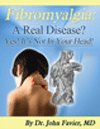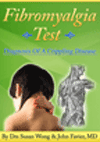Fibromyalgia Inflammation
Fibromyalgia Inflammation
The Marker Of Disease
Inflammation is the natural reaction of a body when a cell is damaged. It has 2 functions: repair the cell or remove it if damaged beyond repair and heal the tissue.
The cell can be damaged by any external or internal factors.
The inflammation reaction is usually controlled. But sometimes the inflammation is uncontrolled and can itself become damaging.
Inflammation can be visible such as the classical redness, swelling, increase in local temperature and pain of the affected tissue.
Any inflammatory reaction is also marked by the release of inflammatory factors. Often, the inflammation is not visible but the inflammatory factors can be measured.
Fibromyalgia does not escape this inflammatory reaction and we now know that inflammatory factors are released. Fibromyalgia inflammation is real!
How important is this?
Well, the first important fact is that it signs the reality of fibromyalgia!
There is now no discussion possible about it: it's real because inflammatory factors are measurable.
For the moment, none of those factors are typical of fibromyalgia which is not surprising. And this fact may remain as such for a long time if not for ever. It is unlikely that any of those factors will become a specific marker of fibromyalgia.
But at least we have the proof that fibromyalgia is a real disease.
The fact that fibromyalgia has many co-morbidities will make this even more complicated because those co-morbidities will have their own inflammatory reactions.
This will not only complicate the whole picture but it also explains that each co-morbidity becomes an added stress worsening the fibromyalgia. With any added inflammation fibromyalgia will get worse.
As we have said in the chapter on obesity in fibromyalgia, cause or consequence become confusedly embroiled and there is no simple answer.
The usual anti-inflammatory drugs are inefficient in fibromyalgia. And this is also true with many chronic inflammations where they loose their effect overtime if not inefficient straight away!
The fact that anti-inflammatory drugs are inefficient is no proof that it is not an inflammation but just that they don't work on this type of inflammation.
I append some references of the many papers that are now showing the presence of inflammatory factors in fibromyalgia. If your doctor is still doubtful about the reality of fibromyalgia, give him/her the references.
References with notes
- Togo F et al. Plasma Cytokine Fluctuations over Time in Healthy Controls and Patients with Fibromyalgia. Exp Biol Med (Maywood). 2009 Feb;234(2):232-40
In this article we discover that at last we have the proof that there are sudden releases of pro-inflammatory cytokines (IL-6) during a 24 hours period.
This is compensated at night by a an increase in IL-10 which is an anti-inflammatory cytokine known to disrupt sleep.
Those sudden burst of pro-inflammatory cytokines during the day have not yet been studied in a possible relationship with stress or after a massage. This is what we called the sudden release of toxins.
The increase of nighttime anti-inflammatory cytokine may explain, at least partly, the sleep disturbance.
IL6 increases bone destruction by direct and indirect action on the osteoclasts and on inhibiting the osteoblasts (bone is permanently destroyed by osteoclasts and rebuilt by osteoblasts--if osteoclasts work more than osteoblasts we develop osteoporosis).
An excess of IL-6 increases
- atheroma (risk of angina, heart attack, stroke and peripheral vascular disease)
- osteoporosis
- fatigue.
Those diseases are more frequent in fibromyalgia than in the normal population and IL-6 could be the reason!
- Haheim LL, Nafstad P, Olsen I, Schwarze PE, Ronningen K. C-reactive protein variations for different chronic somatic disorders. Scand J Public Health. 2009 Apr 16.
Study showing that CRP, an inflammatory marker, is elevated in fibromyalgia. Strangely, the study of diverse diseases in elderly men includes osteoporosis and fibromyalgia. Those 2 diseases are not very prevalent in men. The study finds also an increase in other diseases such as diabetes or myocardial infaction that are not only so common in elderly men but also as an association with fibromyalgia. What was the association of other diseases in the fibromyalgia sufferers? It is so common as to wonder what is the real cause of the elevated CRP in fibromyalgia!
Knowledge Is Power
To understand why, what it is, how to care click on the books!
Pain Relief
Do you want to be heard?
Share your story








New! Comments
Have your say about what you just read! Leave me a comment in the box below.